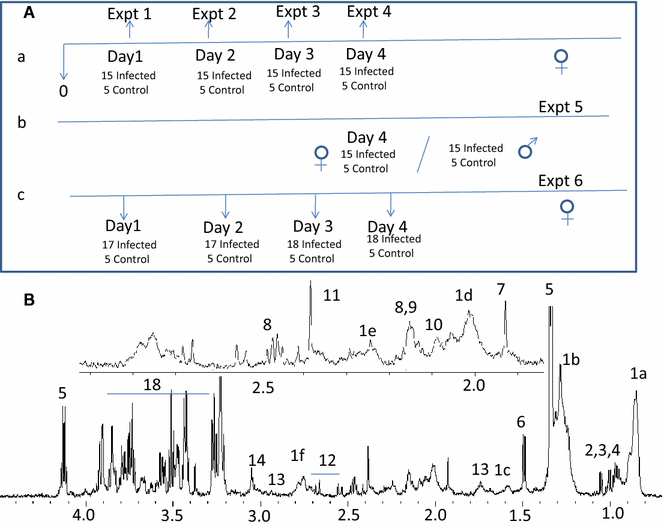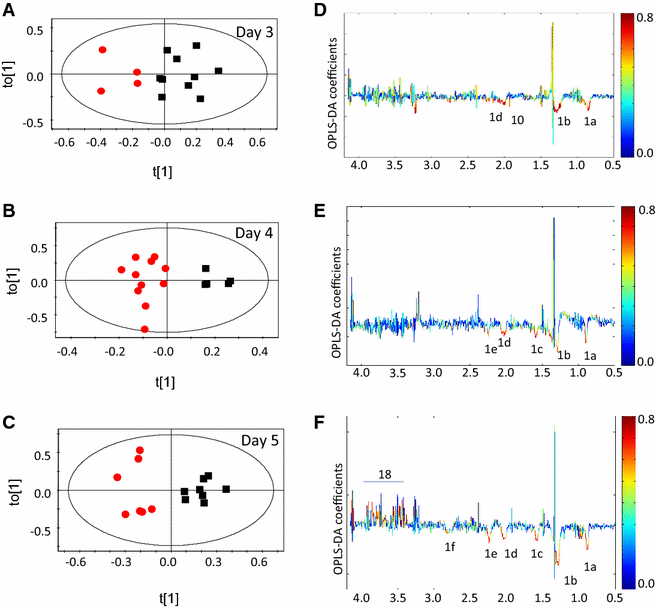Early prediction of cerebral malaria by (1)H NMR based metabolomics
- PMID: 27066781
- PMCID: PMC4828763
- DOI: 10.1186/s12936-016-1256-z
Early prediction of cerebral malaria by (1)H NMR based metabolomics
Abstract
Background: Cerebral malaria (CM) is a life-threatening disease, caused mainly by Plasmodium falciparum in humans. In adults only 1-2% of P. falciparum-infected hosts transit to the cerebral form of the disease while most exhibit non-cerebral malaria (NCM). The perturbed metabolic pathways of CM and NCM have been reported. Early marker(s) of CM is(are) not known and by the time a patient exhibits the pathological symptoms of CM, the disease has progressed. Murine CM, like the human disease, is difficult to assign to specific animals at early stage and hence the challenge to treat CM at pre-clinical stage of the disease. This is the first report of prediction of CM in mice using a novel strategy based on (1)H nuclear magnetic resonance (NMR)-based metabolomics.
Methods: Mice were infected with malarial parasites, and serum was collected from all the animals (CM/NCM) before CM symptoms were apparent. The assignment of mice as NCM/CM at an early time point is based on their symptoms at days 8-9 post-infection (pi). The serum samples were subjected to (1)H NMR-based metabolomics. (1)H NMR spectra of the serum samples, collected at various time points (pi) in multiple sets of experiments, were subjected to multivariate analyses.
Results: The results from orthogonal partial least square discriminant analyses (OPLS-DA) suggest that the animals with CM start to diverge out in metabolic profile and were distinct on day 4 pi, although by physical observation they were indistinguishable from the NCM. The metabolites that appeared to contribute to this distinction were serum lipids and lipoproteins, and 14-19% enhancement was observed in mice afflicted with CM. A cut-off of 14% change of total lipoproteins in serum predicts 54-71% CM in different experiments at day 4 pi.
Conclusion: This study clearly demonstrates the possibility of differentiating and identifying animals with CM at an early, pre-clinical stage. The strategy, based on metabolite profile of serum, tested with different batches of animals in both the sex and across different times of the year, is found to be robust. This is the first such study of pre-clinical prognosis of CM.
Keywords: Cerebral malaria; Lipids; Metabolomics; NMR; OPLS-DA; Prediction.
Figures




Similar articles
-
Metabolic fingerprints of serum, brain, and liver are distinct for mice with cerebral and noncerebral malaria: a ¹H NMR spectroscopy-based metabonomic study.J Proteome Res. 2012 Oct 5;11(10):4992-5004. doi: 10.1021/pr300562m. Epub 2012 Aug 28. J Proteome Res. 2012. PMID: 22838963
-
Multivariate modelling with (1)H NMR of pleural effusion in murine cerebral malaria.Malar J. 2011 Nov 2;10:330. doi: 10.1186/1475-2875-10-330. Malar J. 2011. PMID: 22047045 Free PMC article.
-
Metabolic perturbations of kidney and spleen in murine cerebral malaria: (1)H NMR-based metabolomic study.PLoS One. 2013 Sep 6;8(9):e73113. doi: 10.1371/journal.pone.0073113. eCollection 2013. PLoS One. 2013. PMID: 24039868 Free PMC article.
-
Challenges in the determination of early predictors of cerebral malaria: lessons from the human disease and the experimental murine models.Neuroimmunomodulation. 2009;16(2):134-45. doi: 10.1159/000180268. Epub 2009 Feb 11. Neuroimmunomodulation. 2009. PMID: 19212133 Review.
-
Host responses in malaria disease evaluated through nuclear magnetic resonance-based metabonomics.Clin Lab Med. 2012 Jun;32(2):129-42. doi: 10.1016/j.cll.2012.04.005. Clin Lab Med. 2012. PMID: 22726995 Review.
Cited by
-
Extensive alterations of blood metabolites in pediatric cerebral malaria.PLoS One. 2017 Apr 20;12(4):e0175686. doi: 10.1371/journal.pone.0175686. eCollection 2017. PLoS One. 2017. PMID: 28426698 Free PMC article.
-
Early Perturbations in Red Blood Cells in Response to Murine Malarial Parasite Infection: Proof-of-Concept 1H NMR Metabolomic Study.Life (Basel). 2023 Aug 4;13(8):1684. doi: 10.3390/life13081684. Life (Basel). 2023. PMID: 37629541 Free PMC article.
-
Malaria in India: The Need for New Targets for Diagnosis and Detection of Plasmodium vivax.Proteomics Clin Appl. 2018 Jul;12(4):e1700024. doi: 10.1002/prca.201700024. Epub 2018 Jan 11. Proteomics Clin Appl. 2018. PMID: 29193853 Free PMC article. Review.
-
Metabolic profiling during malaria reveals the role of the aryl hydrocarbon receptor in regulating kidney injury.Elife. 2020 Oct 6;9:e60165. doi: 10.7554/eLife.60165. Elife. 2020. PMID: 33021470 Free PMC article.
-
Oxidative stress, dysfunctional energy metabolism, and destabilizing neurotransmitters altered the cerebral metabolic profile in a rat model of simulated heliox saturation diving to 4.0 MPa.PLoS One. 2023 Mar 14;18(3):e0282700. doi: 10.1371/journal.pone.0282700. eCollection 2023. PLoS One. 2023. PMID: 36917582 Free PMC article.
References
Publication types
MeSH terms
LinkOut - more resources
Full Text Sources
Other Literature Sources
Research Materials
Miscellaneous

